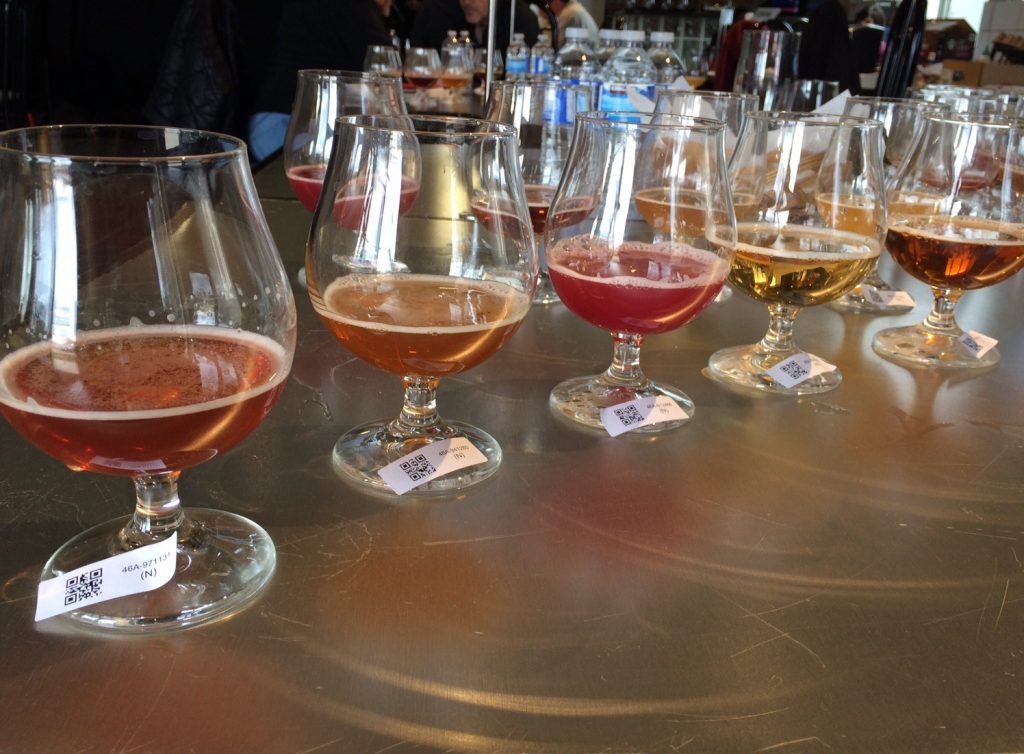
We’ve all been handed a malty ale, a hoppy IPA, a smooth and sweet milkshake IPA, and various other styles of beer. But, have you ever reached for a sour beer?
Famous for a sour and somewhat salty profile is the Gosé. Originating in Goslar, Germany, Gosé beer often entails sourness, herbal notes, and a saltiness that comes from either local water sources or purposefully added ingredients. Any sour beer should be delicately soured, according to BSG’s Deborah Wood, creator of today’s recipe. Historically Goséwas stored in barrel whose flora soured the beer.
Since it’s not always easy to get your hands on a barrel to get those wild yeasts rolling, we recommended the Kettle Souring method. For this, we included a sour starter recipe and directions in this week’s Homebrewing with BSG Recipe, so that you can get your sour, fruity Gosé recipe the proper yeast it needs to achieve that tart sour punch.
Let us know your homebrewed results using the hashtags #BrewWithBSG or #BrewBSG. Happy brewing!
Leipzinger Inspired Contemporary Gosé
Ingredients
for 5 gal.
- 4.5 lb (2,043g) Weyermann® Pale Wheat Malt
- .3 lb (136g) Weyermann® Oak Smoked Wheat Malt
- 4.5 lb (2,043g) Weyermann®Pilsner
- .4lb (182g) Weyermann®Acidulated
- .4lb (182g) Weyermann®Carafoam
- 1 tsp Kosher Salt
- 1tsp Crushed Corriander
Hops (& Spice)
- 1/2 oz (14g) Hallertauer Mittelfruh 4.25aa x 60 min boil
- 1/2 oz (14g) Hallertauer Mittelfruh 4.25aa x 15 min boil
- 1tsp Crushed Corriander x 15 min boil
Yeast
- 1 x 11.5g Fermentis SafAle S04
- Fruit, 2 lbs of fresh or frozen fruit puree to be added to the secondary. Raspberries and other small fruit, sour Cherries & mangos are a great choice.
Specifications
- Original Gravity: 1.040 (10 P.)
- Finial Gravity: 1.006 (2.5 P.)
- ABV: 3.9%
- IBU: 11.9
- SRM: 3.5
- Target ph.: 3.8 -3.9
Ingredients & Directions to make a Sour Starter
- 1 lb Weyermann® Acidulated malt/ milled
- Cheese cloth and string
- 2 liters of water or fresh wort
- A Sour Starter can easily made by putting 1 lb of milled Weyermann® Acidulated Malt in a knotted piece of cheesecloth covered with fresh wort or water which is kept between 24-36 hours at 131F (55C.) A Grainfather is the perfect tool to keep the temperature at 131F (55C.) Remove the cloth bag of acidulated malt when the starter has soured. It is also possible to buy a commercial sour starter to use for making a 1-liter starter for a 5-gal batch of beer.
- Most breweries that are known to brew amazing sour beers often keep a bucket containing a house starter with Lactobacillus, and possibly other funky things, in their beer cooler. This starter is used to inoculate lactic bacteria when starting a Sour Kettle. This is done by filling your boiler with fresh un-hopped wort. The acidity of the wort will be constantly changing and evolving as the flavors develop. Knowing the pH of your favorite sour beers helps you know when it is time to initiate the boil rapidly to stop the souring process.
- The first step is to adjust and maintain the temperature to 131F (55C), then add your sour starter & maintain the temperature till the souring process is completed. You will need to maintain this temperature for between 24 – 36 hours. Approximately 24 hours after the inoculation the fun starts as the pH begins to drop rapidly. You will need to taste and verify the pH of the wort hourly until you have attained the exact degree of sourness that you desire.
- To do this you need to visualize in your mind’s eye where the flavors will be when the fermentation is completed. Having a target pH of your favorite sour beers to guide you helps. Understand that the souring process will continue until you stop it. If you leave the unfermented wort for three days it will just taste like lactic acid (too sour).
- This beer design will enhance, not hinder the fruit addition which will add color, flavor and a lively character to this brew. The basic recipe is a pale golden color and very lightly hopped, the fruit will enhance an already beautiful design and let delicate colors and aromas blossom.
Directions for Mash procedure
- Step Mash procedure, mash in at 131 F (56C) for 20 min, raise to 145F (62.7C.) x 30 min, the raise to 153F (67.2C) x 30 min, then mash out at 172F (78C) for 5 minutes then proceed to sparge at 170 (76C.)
- You want just a bit of saltiness in this beer, add salt very gradually starting with 1 tsp.
A pH. meter is necessary to verify the acidity of the wort. To sterilize the fruit before adding it to the fermenter place pureed fruit in a pot and cover with hot wort which you will then keep above 168 F for 20 minutes before you let it cool or add it directly into the fermenter. Chill to 72 F then add the yeast, aerate and then ferment at 67-70F for 5 days before you transfer to secondary for ageing. The fruit you choose will give color, flavor and a lively character to this brew. The basic recipe is a pale golden color and very lightly hopped, the fruit will enhance an already beautiful design. A second style that is wonderful is a Berliner Weisse with an OG of 1.028 to 1.030, 6 IBU, target pH of 3.6 This beer is very pale in color and has a refreshing sourness. Made with a grain bill of 50% -75% pilsner malt and 50 % to 25% Pale wheat malt.
Cheers!